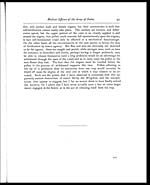Medicine - Institutions > Army health reports and medical documents > Scientific memoirs by medical officers of the Army of India > Part III, 1887 > 5 - Fly-catching habit of Wrightia coccinea
(48) Page 42
Download files
Individual page:
Thumbnail gallery: Grid view | List view

42
Scientific Memoirs by
For the upper half or two-thirds of their length they are closely in contact
with each other, laterally, by means of their winged edges (see Fig. 3, pl. VI),
but they are separated below by narrow slit-like openings, while at the base of
the cone below the tips of the wings and between the stout filaments are left
5 quadrangular openings of considerable size, through which the nectary can
easily be reached.
In every cone there are thus 5 slits, each of which constitutes a separate
trap for insects.
If a thread, a fine straw, or a bristle, imitating the proboscis of a fly, be
introduced into the interior of the cone through one of the basal openings and
then gently withdrawn in an upward direction, it will readily pass into the slit,
where, as traction continues, it soon becomes fixed. If now the hand be raised
still higher, it will be found possible to extract the bristle very slantingly through
the apex of the cone, where the points of the anthers give a little, and in the
process of withdrawal it comes into contact, first, with the sticky stigmatic
tissue, then with the pollen, some of the grains of which will be found adhering
to its point.
It seems to me that the action of the trap is purely mechanical. After
repeated experiments I could not discover any appearance of irritability or sensi-
tiveness of the stamens. Irritation of the interior of the cone had no effect in the
closer approximation of the adjacent wings, the width of the slit remained the
same even after capture of an insect. The slit-like interval between the wings
narrows from below upwards until the sides actually touch. The wings them-
selves are "set" somewhat inwards towards the long axis of the cone (Fig. 6,
pl. VI). They thus tend to fall together valve-like and the whole arrangement
is adapted to favour the wedging in of an impacted proboscis. There is plenty
of room for an insect to withdraw its head or proboscis through the large open-
ing at the base, and it is not easy to understand why entanglement should so
often occur.
Possibly while in the act of searching, the member becomes jammed, and
once caught in the slit all efforts except in one direction, directly upwards, as
has been shewn, only cause it to be held the tighter; so tight, indeed, does the
trap hold that once the struggles of a captured ant were seen to result in its
decapitation.
The free edges of the wings are smooth and hard. A lens reveals no teeth
or ridges, but they are seen to be finely ribbed longitudinally.
The shrubs have now ceased to blossom and want of material prevents
further enquiry at present. From the foregoing the plant clearly is not insecti-
vorous, and there is a strong probability that the fly-catching habit is accidental,
resulting from the arrangements to secure the fertilization of the species. In
the two specimens to which I have had access all the flowers we-re hermaphro-
Set display mode to: Large image | Zoom image | Transcription
Images and transcriptions on this page, including medium image downloads, may be used under the Creative Commons Attribution 4.0 International Licence unless otherwise stated. ![]()
| Permanent URL | https://digital.nls.uk/75004150 |
|---|
| Shelfmark | IP/QB.10 |
|---|---|
| Additional NLS resources: | |



![[Page 41]](https://deriv.nls.uk/dcn4/7500/75004149.4.jpg)
